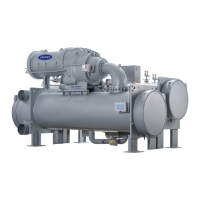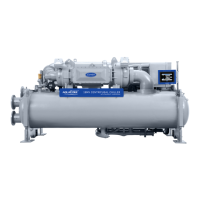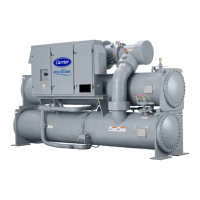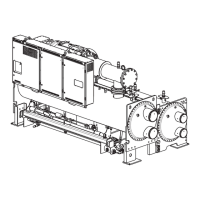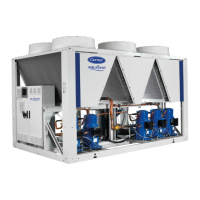95
Water/Brine Treatment — Untreated or improperly
treated water/brine may result in corrosion, scaling, erosion, or
algae. The services of a qualified water/brine treatment special-
ist should be obtained to develop and monitor a treatment
program.
Inspect the Control Center — Before working on
any starter, shut off the chiller, open and tag all disconnects
supplying power to the control center.
Periodically vacuum or blow off accumulated debris on the
internal parts with a high-velocity, low-pressure blower.
Power connections on newly installed control centers may
relax and loosen after a month of operation. Turn power off and
retighten. Recheck annually thereafter.
Recalibrate Pressure Transducers — Once a
year, the pressure transducers should be checked against a pres-
sure gage reading. Check all transducers (up to 9): the oil pres-
sure delta P transducers, discharge pressure transducer, the con-
denser pressure transducer, the cooler pressure transducer, and
the optional water side pressure transducers (consisting of 4
optional flow devices: 2 cooler, 2 condenser).
Note the evaporator and condenser pressure readings on the
HEAT_EX screen (EVAPORATOR PRESSURE and
CONDENSER PRESSURE). Attach an accurate set of refriger-
ation gages to the cooler and condenser Schrader fittings.
Compare the two readings. If there is a difference in readings,
the transducer can be calibrated as described in the Trouble-
shooting Guide section. Oil differential pressure (OIL PRES-
SURE DELTA P on the COMPRESS screen) should be close to
zero whenever the compressor is off. The oil pressure delta P
transducers indicate the difference between oil pressure leaving
filter and oil sump pressure.
Optional Pumpout System Maintenance — For
pumpout unit compressor maintenance details, refer to the
19XR Positive Pressure Storage System Installation, Start-Up,
and Service Instructions.
OPTIONAL PUMPOUT COMPRESSOR OIL
CHARGE — Use oil conforming to Carrier specifications for
reciprocating compressor usage. Oil requirements are as
follows:
• HFC-134a ISO Viscosity. . . . . . . . . . . . . . . . . .68 or 220
• Viscosity SSU 100 F (38 C) . . . . . . . . . . . . .300 or 1005
• Carrier Part Number . . PP23BZ-103 or PP23BZ110005
The total oil charge is 13 oz (0.5 L).
Oil should be visible in the pumpout compressor sight glass
both during operation and at shutdown. Always check the oil
level before operating the pumpout compressor. Before adding
or changing oil, relieve the refrigerant pressure through the
access valves.
Relieve refrigerant pressure and add oil to the pumpout unit
as follows:
1. Refer to Fig. 53. Close service valves 2 and 4.
2. Run the pumpout compressor in Automatic mode for one
minute or until the vacuum switch is satisfied and com-
pressor shuts off.
3. Move the pumpout selector switch to OFF. Pumpout
compressor shell should now be under vacuum.
4. Oil can be added to the shell with a hand oil pump
through the access valve in the compressor base.
NOTE: Compressor access valve has a self-sealing fitting
which will require a hose connection with a depressor to open.
OPTIONAL PUMPOUT SAFETY CONTROL SETTINGS
(Fig. 59) — The optional pumpout system high-pressure
switch should open at 185 psig (1276 kPa) and closes automat-
ically at 140 psig (965 kPa). Check the switch setting by
operating the pumpout compressor and slowly throttling the
pumpout condenser liquid.
CAUTION
Water/brine must be within design flow limits, clean, and
treated to ensure proper chiller performance and to reduce
the potential of tubing damage due to corrosion, scaling,
erosion, and algae. Carrier assumes no responsibility for
chiller damage resulting from untreated or improperly
treated water/brine.
WARNING
Before working on any VFD, shut off the chiller, open and
tag all disconnects supplying power to the starter. After dis-
connecting input power to a VFD and before touching any
internal components, wait 5 minutes for the DC bus capaci-
tors to discharge, then check the voltage with a voltmeter.
Failure to observe this warning could result in severe
bodily injury or death.
WARNING
The disconnect on the front of the control center does not
deenergize all internal circuits. Open all internal control
power and remote disconnects before servicing the starter.
CAUTION
The motor leads must be disconnected from the VFD
before an insulation test is performed. The voltage gener-
ated from the tester can damage the drive components.
WARNING
Never open isolating knife switches while equipment is
operating. Electrical arcing can cause serious injury.
CAUTION
Loose power connections can cause voltage spikes, over-
heating, malfunctioning, or failures.
CAUTION
Compressor oil is hygroscopic. Containers should remain
tightly sealed in clean and dry environments to prevent
moisture absorption from the air.

